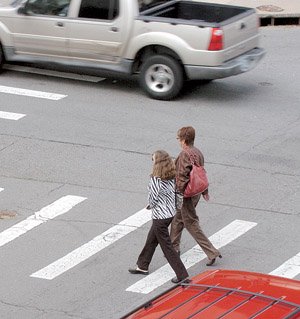LITTLE ROCK — Pedestrians in Arkansas metropolitan areas need to be extra careful crossing the street, according to a new study that found the state’s cities among the more dangerous places in the nation for pedestrians.
The Memphis metropolitan area, which includes parts of Arkansas, ranked as the fifth most dangerous among the nation’s 53 metropolitan areas with populations exceeding 1 million. The study found the Pine Bluff and the Little Rock metro areas even more dangerous, though neither city has a high enough population to be ranked.
The study, Dangerous by Design, was released Monday by Transportation For America and the Surface Transportation Policy Partnership. Both bill themselves as national coalitions working to make communities safer with more transportation choices to “enhance the economy, improve public health, promote social equity and protect the environment.” They recommend more spending on road designs that incorporate sidewalks and other features to protect pedestrians.
Nearly 5,000 pedestrians die annually on U.S. roads, a figure that Ann Camby, president of the Surface Transportation Policy Partnership, likens to one jumbo jet crashing every month.
“If that were to happen, there would be outrage,” she said during a teleconference with reporters Monday.
The study developed a Pedestrian Danger Index to rank metropolitan areas by looking at the rate of pedestrian deaths relative to the average amount of walking residents do.
The Top 5 most dangerous places all were in the South. The Top 4 were in Florida: Orlando-Kissimmee; Tampa-St. Petersburg-Clearwater; Miami-Fort Lauderdale-Pompano Beach; and Jacksonville. Their Pedestrian Danger Index ranged from a high of 221.5 to 137.7.
By contrast, the safest places for pedestrians were led by Minneapolis-St. Paul-Bloomington, Minn-Wisc., which had a Pedestrian Danger Index of 22.3. Next came Boston-Cambridge-Quincy, Mass.-N.H.; New York-Northern New Jersey-Long Island, N.Y.-N.Y.-N.J.-Pennsylvania; Pittsburgh, Penn.; and Seattle-Tacoma-Bellevue, Wash.
All but one of the eight metropolitan areas in Arkansas exceeded the national average Pedestrian Danger Index of 52.1. Pine Bluff, with a 289.9 rating, was the worst while the Fayetteville-Springdale-Rogers metropolitan area ranked as the best in the state with a 39 on the index.
In the period covered by the study, Pine Bluff had 8 pedestrian deaths. Its 2008 population was 100,647. The Fayetteville metro area had the same number of deaths but its population - 443,976 - was more than four times the population of Pine Bluff. About 1.4 percent of Pine Bluff residents walked to work whereas 2.3 percent of residents in the Fayetteville metro area walked to work.
The Pedestrian Danger Index for the Little Rock metro area was 173.6. It had 30 pedestrian fatalities, which made up 12.7 percent of all traffic deaths in the area. About 1.3 percent of its population of 675,069 walked to work.
Overall, Arkansas had 92 pedestrian fatalities over the two years covered by the national study - 2007 and 2008. In Arkansas, 7.4 percent of total traffic deaths were pedestrians; the national average was 11.8 percent. Arkansas’ pedestrian fatality rate per 100,000 people of 1.62 was higher than the national average of 1.53.
The study found that just under 1 percent of the $1.5 billion in federal transportation money available in Arkansas during the period studied was spent on pedestrian projects. That spending amounted to $1.16 per Arkansan.
The study’s authors conceded the spending they identified on pedestrian projects didn’t include pedestrian facilities embedded in larger highway construction projects.Including sidewalks on urban arterial roads, which are roads connecting city streets to major highways or freeways, is a state standard, said Randy Ort, an Arkansas Highway and Transportation Department spokesman.
The department also conducts studies to determine whether sidewalks or other pedestrian friendly facilities are warranted. “There won’t be a sidewalk but maybe there’s worn grass,” Ort said. “It’s evidence of pedestrian traffic.”
The national study also comes as Metroplan, the long range transportation agency for central Arkansas, has been compiling its own data on pedestrian injuries and fatalities in the region. Casey Covington, a planning engineer, is scheduled to present the agency’s findings Thursday at the request of the Transportation Advisory Council, a group of lay people who help identify the region’s long-range transportation goals and strategies.
Covington looked at a three-year period beginning in 2006, which saw a total of 34 pedestrian fatalities in Pulaski, Faulkner, Lonoke and Saline counties. A dozen fatalities occurred on state highways, 10 occurred on freeways or interstates, seven happened on city streets, three on interstate frontage roads and two on county roads.
More than half of the fatalities occurred at night and nearly 40 percent involved alcohol, either on the part of the pedestrian or the driver, according to Covington’s look at the data.
Metroplan has had in place design standards that incorporate sidewalks on all road construction projects that include federal aid since 1995, said Jim McKenzie, the executive director for Metroplan.
He noted the agency also has helped build paths and bridges for pedestrians and bicyclists, including the Big Dam Bridge over the Arkansas River and the Arkansas River Trail.
Arkansas, Pages 7 on 11/10/2009

